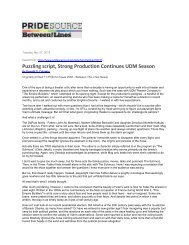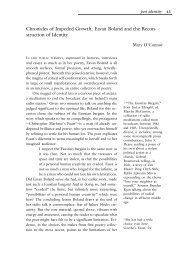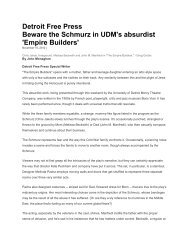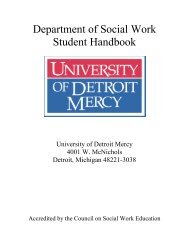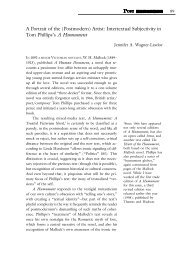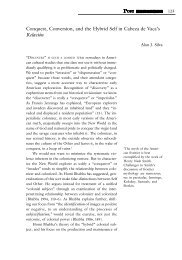Kazuo Ishiguro's Persistent Dream for Postethnicity: Performance in ...
Kazuo Ishiguro's Persistent Dream for Postethnicity: Performance in ...
Kazuo Ishiguro's Persistent Dream for Postethnicity: Performance in ...
Create successful ePaper yourself
Turn your PDF publications into a flip-book with our unique Google optimized e-Paper software.
understandably even more difficult <strong>for</strong> the public to accept<br />
than that of Escher’s lithograph or, <strong>for</strong> that matter, Kafka’s<br />
“Metamorphosis.” Whereas his predecessors cast their commentaries<br />
<strong>in</strong> explicitly allegorical terms, those of centipedes<br />
or a beetle, Ishiguro never deviates from the human world<br />
and never provides any sense of <strong>in</strong>sulation. Ishiguro gives,<br />
<strong>in</strong> the words of Carlton Lake <strong>in</strong> description of Dali’s “paranoic-critical<br />
method,” “the most <strong>in</strong>congruous or unbelievable<br />
material such detail and precision that it acquired,<br />
<strong>in</strong> the process, a life of its own and became almost plausible”<br />
(68–9). What dooms the reception of his novel may<br />
well be that the “detail and precision” is such that it becomes<br />
too plausibly the reader’s own life.<br />
Reactionary Whiteface Subsum<strong>in</strong>g Differences<br />
Yet neither Rema<strong>in</strong>s nor Unconsoled is truly postethnic.<br />
The English-ness of Stevens and Ryder is, <strong>in</strong> theory if not<br />
<strong>in</strong> practice, just as ethnic as the Japanese-ness of Etsuko<br />
and Ono. That one could only claim this on the theoretical<br />
plane bears witness to the grow<strong>in</strong>g realization, best<br />
embodied <strong>in</strong> George Lipsitz’s essay “The Possessive Investment<br />
<strong>in</strong> Whiteness,” that whiteness has long rema<strong>in</strong>ed<br />
<strong>in</strong>visible <strong>in</strong>, and thus beyond, racial discourse. This <strong>in</strong>visibility<br />
derives from the whites’ majority status and their<br />
control of discourse and material resources. The ethnic<br />
group <strong>in</strong> power is usually less <strong>in</strong>cl<strong>in</strong>ed to exam<strong>in</strong>e the correlation<br />
between its race and its power. There<strong>for</strong>e, Ishiguro’s<br />
shift to English characters and postethnicity may suggest<br />
problematics much more troubl<strong>in</strong>g than a m<strong>in</strong>ority’s reaction<br />
aga<strong>in</strong>st identity politics pigeonhol<strong>in</strong>g him as noth<strong>in</strong>g<br />
but an Anglo-Japanese. Ethnic writers can conceivably<br />
imag<strong>in</strong>e ways to become more, not less, ethnic. Why does<br />
ethnicity have to make way <strong>for</strong> postethnicity, an illegitimate<br />
heir probably one’s own yet alarm<strong>in</strong>gly white? Why<br />
should the ethnic community accept one writer’s flirtations<br />
with postethnicity, perhaps a code word <strong>for</strong> “whiteness”?<br />
One hastens to add that it is undoubtedly subversive<br />
<strong>for</strong> a m<strong>in</strong>ority to per<strong>for</strong>m <strong>in</strong> whiteface. Given the long<br />
history of blackface m<strong>in</strong>strelsy <strong>in</strong> North America and its<br />
permutations <strong>in</strong> Europe, it is hearten<strong>in</strong>g to see an Anglo-<br />
Sheng-mei Ma<br />
POST OST IDENTITY IDENTITY 79




